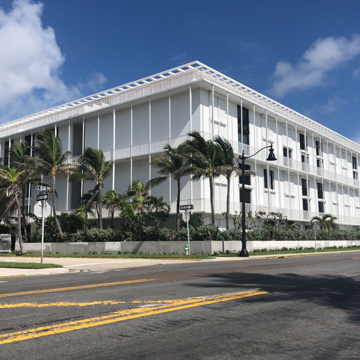You are here
400 South Ocean Boulevard
The apartment building at 400 South Ocean Boulevard in Palm Beach, now known simply as “The 400,” was Edward Durell Stone’s first foray into architecture in Florida and his first attempt at designing an apartment building. Stone was drawn to South Florida by his son Edward Durell Stone Jr., who had recently established his own landscape architecture firm in Fort Lauderdale, and was a natural partner for the project. Sited just a block north of Worth Avenue, the famed street developed from Mizner’s Everglades Club on Lake Worth, and separated from the ocean by South Ocean Boulevard, The 400 brought middle- and upper-middle-class, full- and part-time residents close to the social core of Palm Beach without the burdensome and expensive requirement of having to own a “cottage.”
Structured around a central courtyard, the white, six-story building contains sixty-eight duplex units. Parking for over ninety cars is located in a semi-submerged garage surrounded by green foliage. Around most of the perimeter, a layer of spindly columns hold up narrow balconies. The building is crowned by a light screen that projects over the penthouse apartments and the rooftop pool. Dark window frames and mullions hold tinted glass protected by white screens or hurricane shutters, which create an irregular, syncopated rhythm of light and shadow across an otherwise simple, cubic white envelope. In the central courtyard, plants and sculptures float on circular islands of various sizes in a blue rectangular pool of water surrounded by travertine floors.
The architectural scheme for The 400 shares elements familiar in other works by Stone, most notably in his American Embassy in New Delhi (1959), which also includes into its design the thin verticals, horizontal layering, and central courtyard water feature with islands. The persistent vertical members that encircle the rectilinear volume of The 400 reverberate in his contemporary P.S. 199, the Jessie Isador Straus School (1963) on 70th Street near West End Avenue in Manhattan. The 400, however, opened other opportunities for Stone in Florida, wherein he explored similar distinctions between light and dark, thick and thin, and vertical and horizontal patterning. These included the Koff Apartments in Deerfield Lake (1965) and the Capitol Center in Tallahassee (1969–1977).
The 400 was one of the first rental buildings to be converted into condominiums under the new Florida Condominium Act of 1963. It is notable for having quickly developed condo legal documents that have been used as models for other buildings across the state. In 2000, Stone’s son, architect Hicks Stone, restored and updated the condominium complex, including new grillwork, entrances, and elevator cabs.
References
De Holguin, Beatrice. Tales of Palm Beach. Palm Beach, FL: Vantage Press, 1968.
Stone, Edward Durell. Recent and Future Architecture.New York: Horizon Press, 1967.
Stone, Hicks. Edward Durell Stone: A Son’s Untold Story.New York: Random House, 2011.
Writing Credits
If SAH Archipedia has been useful to you, please consider supporting it.
SAH Archipedia tells the story of the United States through its buildings, landscapes, and cities. This freely available resource empowers the public with authoritative knowledge that deepens their understanding and appreciation of the built environment. But the Society of Architectural Historians, which created SAH Archipedia with University of Virginia Press, needs your support to maintain the high-caliber research, writing, photography, cartography, editing, design, and programming that make SAH Archipedia a trusted online resource available to all who value the history of place, heritage tourism, and learning.

